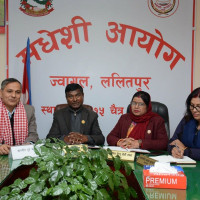- Thursday, 8 January 2026
White-rumped vulture making resurgence
Kathmandu, Aug. 26: Following a decline in their population, White-rumped vultures (Gyps bengalensis) have shown a positive trend. Nesting in the Arghakhachi district of central-western Nepal, these vultures displayed consistent and stable reproductive rates over a period of 11 years.
Two groups of nesting white-rumped vultures, called dangar giddha in Nepali, confirmed stable reproductive rates during that period. From 2002 to 2011, Nepal witnessed a shocking 91 per cent decrease in white-rumped vulture numbers, pushing them to the edge of global critical endangerment, said Krishna Prasad Bhusal, the author of the research paper “Population and Productivity of the Critically Endangered White-Rumped Vulture in the Argha Important Bird and Biodiversity Area,” published in the Journal of Raptor Research.
According to Bhusal, they visited the groups three times per breeding season between 2010 and 2021 to monitor nesting success, observe nest site characteristics, and collect an understanding of population trends. The findings bore a positive outlook and the results were good. “The proof was in how many baby vultures successfully flew from each nest. During the study, more nests were used, and the baby vulture count per nest stayed steady,” he informed.
These pairs are nesting within the Argha Important Bird and Biodiversity Area, a globally significant landscape designated in 2015 for the sake of globally threatened birds, including the white-rumped vulture and two other critically endangered Red-headed vultures and Egyptian vultures.
White-rumped vultures are native to Asia. Like other vultures, they provide an essential ecosystem service through their efficient removal of carcasses. This is especially true in Nepal, where cattle are raised for milk but not for meat, resulting in many uneaten carcasses, the paper said.
Globally, 75 per cent of vulture species are listed as either endangered or critically endangered by the International Union for the Conservation of Nature (IUCN). These declines are the direct result of human actions including the use of an anti-inflammatory drug for cattle called diclofenac, which causes kidney failure in vultures, killing them en masse due to their communal feeding behaviour, vulture expert Bhusal said.
“The rapidity of these population declines resulted in a domino effect of consequences, such as the spread of diseases and their mammalian vectors. Vultures were the clean-up crew,” he said.
Vultures, the dedicated scavengers, hold a vital place in ecosystems, both natural and human-influenced, by clearing animal carcasses. Their
role becomes particularly significant in countries like Nepal, where cattle are reared for milk, leading to a surplus of carcasses in need of disposal, the research said. Moreover, vultures are culturally significant as they are entangled with sky burial practices in Nepal’s trans-Himalayan region.
Breeding-wise, vultures are monogamous and stick to the same nest yearly, usually built in tall trees forming loose colonies. Their breeding season spans from October to April. To protect the vultures from poisoning, communities across the world rallied to ban diclofenac and establish vulture conservation programmes. Along with India, Nepal was among the first.
Bhusal emphasised the importance of the study in confirming the success of vulture conservation efforts in Nepal. These efforts relied on the help of local people. They created “Vulture Safe Zones” in 2009, which are areas around vulture nests where diclofenac is not used. These zones, along with raising awareness in the community, have greatly helped protect these vultures, according to Bhusal.
Bhusal and his fellow authors, including Ankit Bilash Joshi, Deu Bahadur Rana, Deelip Chand Thakuri, and Christopher J. W. McClure, highlighted some fascinating discoveries: Especially, most vulture pairs chose to nest in chir pines (Pinus roxburghii), a tree native to the Himalayas and crucial for nesting vultures. Furthermore, a noteworthy observation was made in 2021, where the study recorded the highest count of occupied nests, a staggering 24 in number.
Bhusal mentioned that the people living near the study area are enthusiastic and take active steps to safeguard the vultures. They are keenly involved in the vultures’ protection and even take part in the annual International Vulture Awareness Day.
According to Bhusal, he has the vision to explore how climate change and human activities impact the breeding behaviours of white-rumped vultures. His goal also involves ongoing monitoring of the two colonies. He said that this study’s success could inspire similar efforts in different places. Conservationists are united in their belief that we need to enhance our understanding of endangered vultures and the ecosystem factors that can facilitate their resurgence in the skies, Bhusal informed.

















